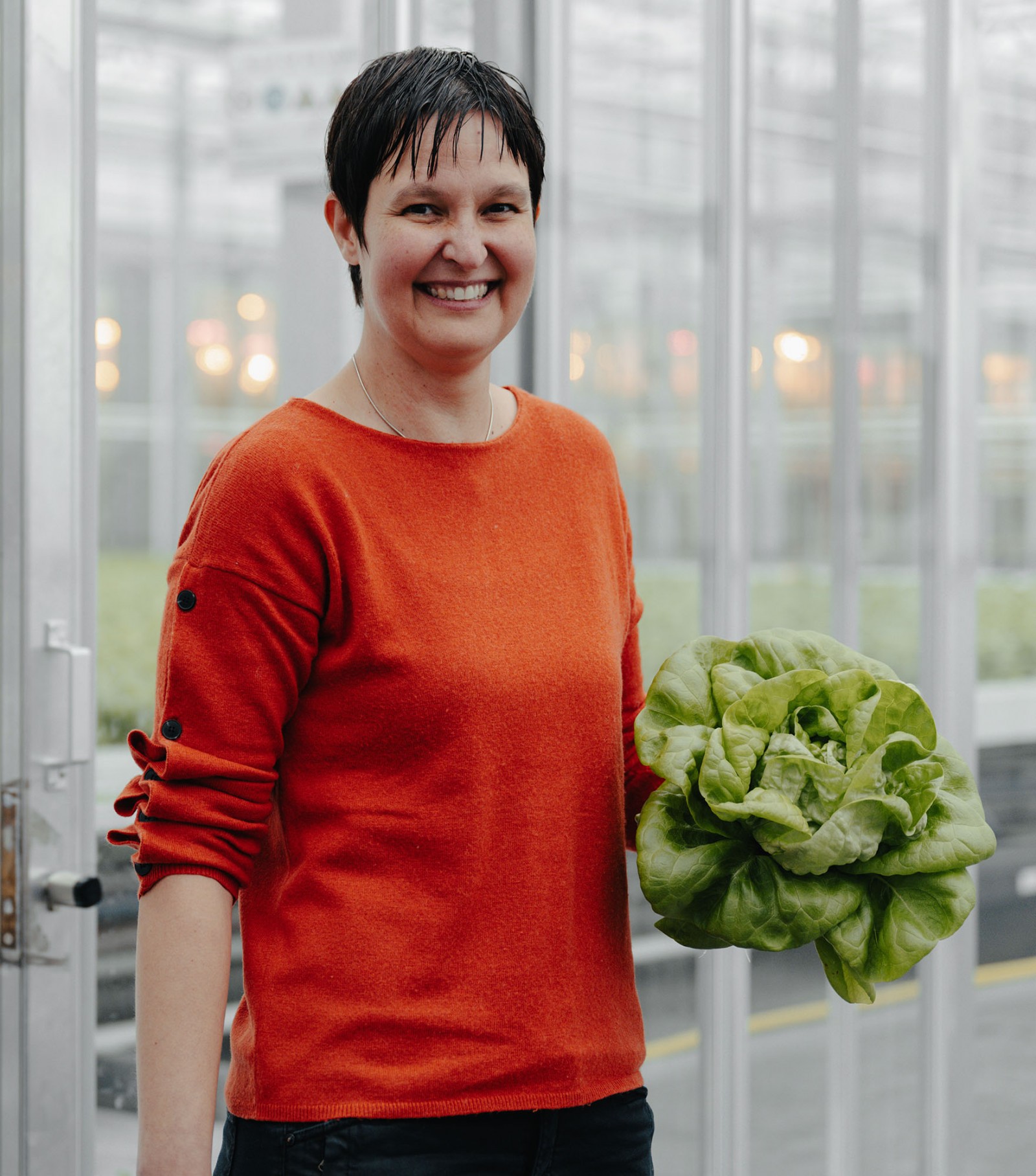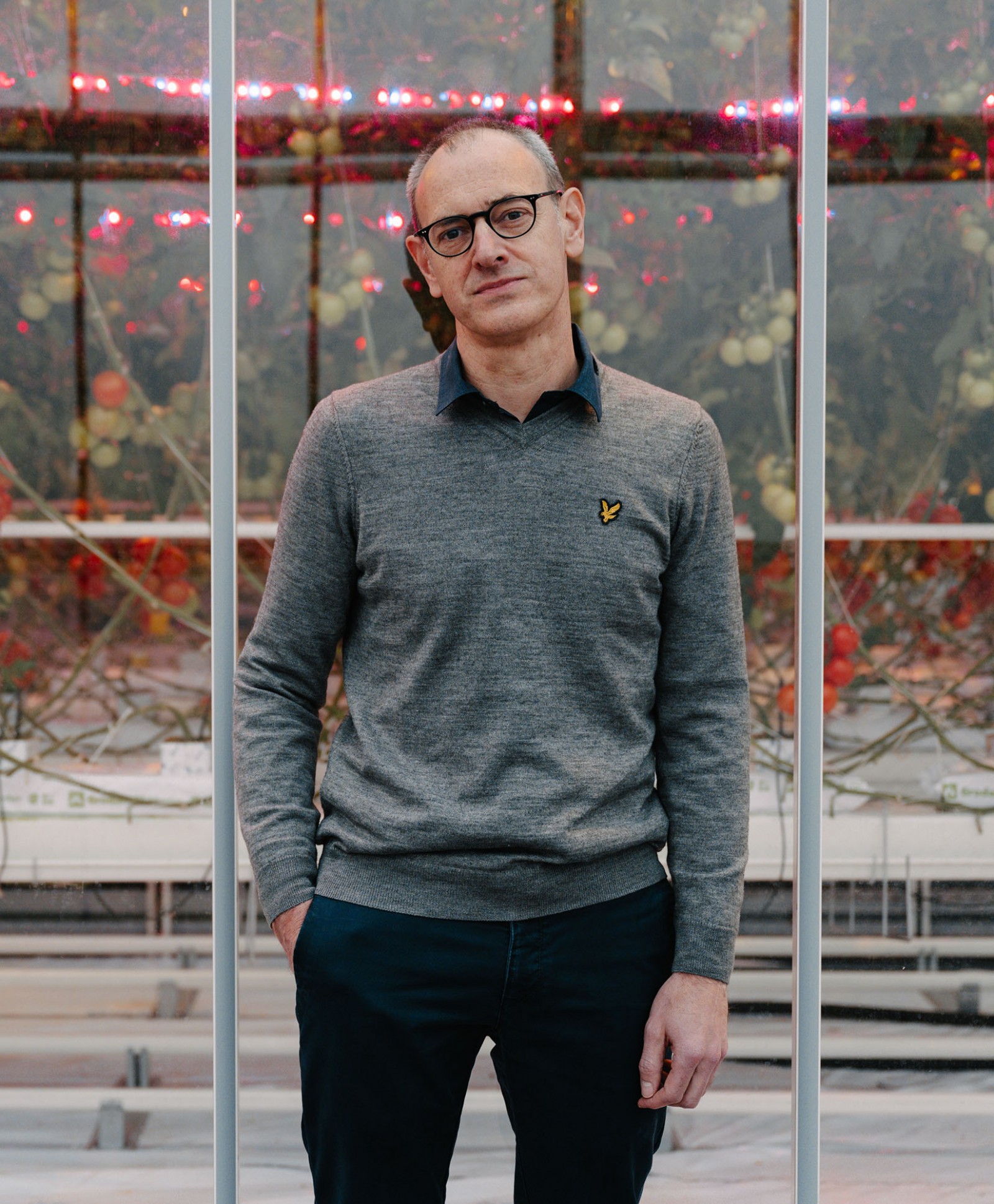Vertical farming is booming, and above all in an urban context, since this method requires less space in order to grow sufficient food for a large number of people. Vertical farming is an agricultural concept where crops are grown in a tall greenhouse, in vertically stacked layers. The plants are not planted in earth; instead, they are cultivated in nutrient-enriched water. Artificial light is needed to ensure that the plants receive enough light in order to grow. But which sort of light gives the best result? This is the focus of one of the studies by a team of bio-engineers from Ghent University.
“Do you see the edge of this leaf?” Professor Kathy Steppe holds up a lettuce, pointing to the brown edges that can be seen on some of the leaves. “We are still not quite sure why this happens. It could be due to still air trapped within the lettuce itself, which blocks the plant’s ability to transpire, meaning that the young leaves are deprived of calcium.” For Kathy, there is nothing in the least bit strange about sweating plants. She studies how plants react to their environment, using plant sensors and other innovative gadgets. And even using 3D models.
A three-dimensional lettuce
“Yes, that’s right! We’re going to create 3D models of lettuces. A virtual world, but one in which we can actually cultivate live lettuce. This will allow us to observe how a lettuce plant reacts to a multitude of different environmental factors. We will also be able to influence the external quality of our lettuces: we can choose what sort of plant we want to cultivate: softer-leaved plants for the fresh food markets, or lettuces with crispier leaves that for chopping into salads. Just to be clear, we are not using any kind of genetic modification at all, just adjusting the environmental conditions. And this of course includes the lighting.”

This seems a laborious process: why not just grow an ordinary lettuce and see how it reacts to its environment? “With vertical farming this quickly becomes way too complex. When you grow lettuces in vertical layers, the environment is much more complicated,” explains Kathy. “ You have all sorts of variables to choose from: you can create layers at different heights, you can play with the colour and the strength of the light, you can regulate the air flow, etc. etc. This in turn also means a lot of different potential combinations that need to be explored as we seek to achieve a crop that is both optimal and sustainable. There are just too many permutations for us to be able to conduct experiments to test them all out. Which is why we are opting for 3D modelling.”
Using 3D, Kathy can observe how the lettuces grow and react to their environment. The model will provide a virtual scenario of how the plants will evolve in reality. In this way, Kathy can predict and, if necessary, adapt both the yield and the external quality of the plants. “We chose to use lettuces because they are compact plants, and thus ideal for cultivation in layers. We will also be able to monitor the direct impact of the controlled environment on the final result, which makes lettuce interesting as a test case. In the meantime we have already started to model other crops. We believe that this concept of using 3D will become a real trendsetter within the greenhouse horticulture sector.”
A primer made from light
Artificial light is extremely important for greenhouse cultivation: sometimes there is simply too little daylight, or, even worse, no daylight at all, and then extra lighting becomes essential. And this is especially true for multi-layer cultivation, where plants are growing very close to each other.
Academic Patrick De Clercq has discovered that the right choice of lighting can enhance a plant’s natural defence against disease: “When we placed vertically growing bean plants under both red light and red and blue light, we found that the plants appeared to be less susceptible to one particular insect that attacks all sorts of crops: the spider mite. Thus, by coating the plant with a sort of primer made from light, as it were, we have found that we can make it more resistant to these sorts of parasites. And that is really interesting, because it means that we then need less crop protection products to protect the plant from sickness and disease.”

These crop protection products can be chemical pesticides, but may also be other animals. “If you buy a tomato in the supermarket, it ia most likely to have been treated with a biological pesticide. This doesn’t mean that it has been sprayed with some chemical or another; in this case we are talking about the natural enemies of certain harmful insects.” Other insects, in other words - Patrick’s particular area of expertise: “The real champion when it comes to biological pest control is the ladybird. Ladybirds eats aphids, and thus protect plants from the damage that aphids can cause. Tomato plants and a whole host of other plants can be protected from harmful pests by deploying their natural enemy against them, instead of using a chemical pesticide.”
Working together with a number of test centres, Patrick De Clerq plans to research whether the light treatment he has been testing out on the bean plants will also be effective with other plants, other diseases and other biological controls: “So far we have made a study of just one sort of plant, one sort of sickness and one sort of biological control agent, so there is not too much that we can say. The question is, will this method work equally well for tomatoes, cucumbers and strawberries? That is what we are now going to test further.”
Agrotopia: a greenhouse and a university chair
The two bio-engineers are using Agrotopia for their experiments. Since last summer, this impressive rooftop greenhouse, with a cultivation surface measuring at least 6000m2, can be seen glistening in the sun on top of the REO Veiling building, the fruit and vegetable market in Roeselare. The greenhouse was commissioned by Inagro, the West Flemish institute for agricultural and horticultural research and education.
Now, with the creation of an eponymous university chair, Ghent University is taking the lead in developing the horticulture of the future: greenhouse horticulture and professional vertically stacked urban horticulture. It comprises many different areas of study: light, climate control, plant sensors and 3D modelling, greenhouse construction, plant physiology and sickness, microbial ecology and technology.. .
“Thanks to this new chair, we can put encouraging results from our laboratory-based research into practice in the Agrotopia greenhouse, and then experiment further. That is an important step as we look to introduce new technologies to greenhouse horticulture,” says Professor Jan Pieters, the chair’s holder. “We are working directly with the horticultural sector: in each project, we involve both researchers and growers from the outset, and they remain involved throughout the innovation process. In this way, we can focus on the specific needs of the sector, and evaluate directly with them if and how the projects can be put into practice. This means that our innovation is perfectly tailored to meet the needs of the target group. And this in turn will make it easier to introduce new projects into the market,” Jan concludes. The Agrotopia Chair is financed by Inagro and REO Veiling.
The Ghent University Agrotopia endowed chair presents an inspiring framework to stimulate and realize innovative concepts in greenhouse technology and vertical and urban horticulture.
Read also
Is a stool transplant a potential treatment for Parkinson’s?
A recent study into Parkinson’s disease has shown that a stool transplant may constitute a new and valuable treatment of the disease. “It offers a potentially safe, effective and cost-efficient way of alleviating the symptoms and improving the quality of life of millions. A 'bacterial pill' might replace the stool transplant in the future. But more research is needed.”
In her will, Anja wants to save animals at the Ghent University animal hospital
Six months ago, Anja Peumans made the decision: she changed her will so that part of her inheritance would go to the Ghent University Animal Clinic. “I felt like a weight had been lifted from my shoulders. Finally, I thought, I can fulfil my dream after I am gone”.
Breakthrough in Alzheimer’s research thanks to donations and legacies
De ziekte van Alzheimer, frontotemporale dementie en ALS zijn verwoestende neurodegeneratieve ziekten zonder uitzicht op herstel. UGent-professor Bart Dermaut, klinisch geneticus en arts, realiseert met zijn wetenschappelijk onderzoek een doorbraak die toekomstige therapieën een nieuwe richting kan uitsturen. Mede dankzij schenkingen en erfenissen van patiënten.
Extra opportunities for young cancer researchers
Cancer researcher Celine Everaert is currently developing an important test that should help to improve treatment for cancer patients. This is possible because of a scholarship, funded by donations and bequests.

